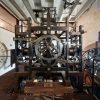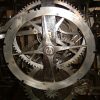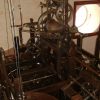The Clock machinery. The heart of the Clock is a complicated system of gear wheels located within a large cruciform metal framework at the center of the Tower. The true ‘engine’ of the entire timepiece, this can be broadly divided into 4 distinct sections; along with these there is the machinery for the astronomical clock face and the workings of the clock barrels. Also known as ‘clock trains’, these 4 sections are similar in appearance and basically comprise: a barrel around which is wound a chain (formerly a rope) to which is attached the motor weight (100 kgs); an intermediate wheel; a rotating fan that serves as an aerodynamic brake to regulate the weight’s speed of descent and thus the interval between clock strokes. The fans are equipped with a ratchet that makes a very recognisable sound; this is activated at the end of each series of strokes and serves to disperse the accumulated kinetic energy when the rotating mechanism comes to an abrupt halt. The clock train transmits the impulses which enable the pendulum to continue its isochronic oscillations (the very basis of the mechanism’s precision). It also comes into play at fixed intervals to trigger the other trains of wheels and pins. By means of thin vertical rods, it activates the barrel machinery every 5 minutes; as a result the minute barrel rotates through 30° (1/12 of a turn). Every 60 minutes, the hour barrel does the same. Upon each hour, the train mechanism for the Two Moors is activated. Two minutes before the hour, the Moor on the right strikes the bell; two minute after the hour, it is the turn of the Moor on the left. This is why the mechanism is described as a ‘re-striking’ one. With the hammers they hold, each Moor strikes the bell on the top of the tower a total of from one to twelve blows, depending upon the hour. Finally, every 12 hours, the 132-stroke train is set in motion. These 132 ‘meridian’ strokes occur at midday and midnight before the Moors strike the bell. They are rung by 2 supplementary hammers placed around the circumference of the bell; the number of strokes corresponds to that of the strokes hit by the two Moors in the previous 11 hours. The barrel mechanism also operates the astronomical machinery via the Moors wheel, which goes through a complete rotation every two hours, and a 22-tooth pinion. This latter goes through 12 rotations a day, turning all 264 teeth (22×12) on the large wheel, which turns the sun clock-hand through one entire circuit per day. Finally, via a return mechanism and a long axle under the clock machinery, the Barrel Mechanism also operates the hour hand on the clock face giving onto the Mercerie. The whole thing is driven by means of 5 train mechanisms, periodically recharged by the raising of the weights. The pendulum and the anchor escapement regulate the perfect release of energy, so that the mechanism works in a constant, even manner. Still perfectly functional, the entire structure dates back to 1753-57, when Bartolomeo Ferracina significantly modified the original machinery built at the end of the 15th century by G. Carlo Ranieri.



